5G-enabled remote broadcast production comes to life at IBC Showcase
Ten broadcast organisations embark on ground-breaking technology demo
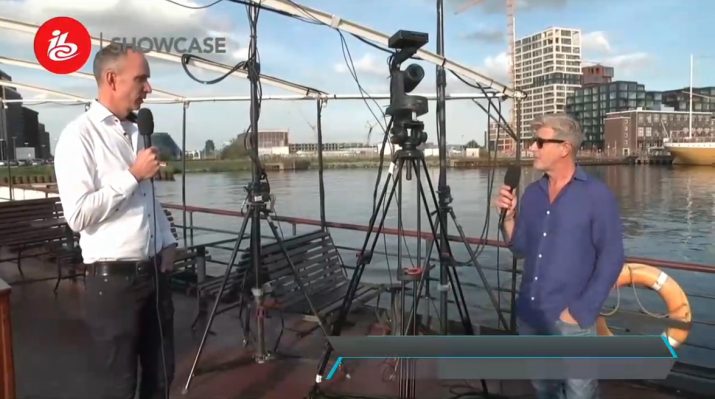
Mobile Viewpoint CEO Michel Bais (L) with IBC Accelerator lead Mark Smith on board the Kapitein Anna on Thursday 10 September
An ambitious and innovative proof of concept live demonstration of 5G-enabled remote production was undertaken in Amsterdam and London last week as part of the IBC Showcase Accelerator Innovation Programme.
The project team, led by BBC R&D senior technology transfer manager Ian Wagdin, comprised ten international broadcasting ‘champions’: Al Jazeera Media Network, BBC, BT Sport, EBU, ITV, Olympic Broadcasting Services (OBS), SVT, TV2, ViacomCBS Networks International (VCNI) and Yle. Technology for the proof of concept was provided by six ‘participant’ companies: Aviwest, Huawei, LiveU, Mobile Viewpoint, NewTek and Sony.
Speaking on an IBC Showcase session ahead of the live demonstration, Ian Wagdin said: “Our challenge earlier this year was to explore and understand the ‘art of the possible’ in terms of a 5G-powered broadcast system, based on current and future use cases and a series of production scenarios in the field.
“With the IBC Show not happening this year, we seized on the creative opportunity to put those learnings into action by designing and configuring a live, multi-camera production as a demonstrator from three locations, that will bring a flavour of a much-missed Amsterdam to IBC’s audience,” said Wagdin.
“For all of the champions, it’s just a great opportunity to have a really deep dive and to understand the technology and understand the limitations, and where this is going. It’s still an emerging use-space.”
“For the first part of the demo we’ve teamed up with LiveU and Sony with a couple of cameras connected to an LU800 and we’re bringing that back via the VodafoneZiggo network, actually installed inside the Rai, to our friends at ViacomCBS in London who are decoding it and will form part of the stream you’re going to see today.
“That’s one part of the demo. We’re also going to another location in Amsterdam where ViacomCBS have their headquarters, and on the shore there we’re using Sony XDCAM cameras and we’ve got some remote controlled 5G lighting. We’ve also got a feed from that into the Sony virtual production cloud. MTV are doing some work on that in Amsterdam, which is going to go out on their Push channel, and then we’re taking a feed of that back to London.
“This is probably the bit where we’ve struggled most,” he said. “We really wanted to look at non-public networking (NPN) here and Huawei have worked closely with us on this. Unfortunately, we just couldn’t get the kit in the right place at the right time and the spectrum to marry it up. We’ve done lots of lab tests and we know it works – but actually getting it to work in Amsterdam was just a step too far during lockdown. So we’re not going to [employ 5G] for bit of the production – we’ve reverted to WiFi technology in that space.
“But not to be outdone we’ve also got a boat, the Kapitein Anna, in Amsterdam. MTV is featuring the brilliant singer Emma Heesters on that boat, singing two songs for us. Mobile Viewpoint has its X-Cam there which is running an AI engine, giving us a feeling that we’ve got multiple cameras, to get that musical performance across. We’ve got more 5G-controlled lights on the boat, and to join it all together we’ve got a drone flying around – all of this running over a network slice with bandwidth provided again by VodafoneZiggo.
“We’ll also have a flying visit to the IBC office in London. That’s going to be coming in through the EE public network via a Sony Xperia 5G phone. Finally, all of these different feeds and streams are coming into a NewTek Tricaster 2 Elite located at ViacomCBS’ London Camden headquarters. It’s really ambitious, we’ve got lots of links, and fingers crossed it’s all going to work!
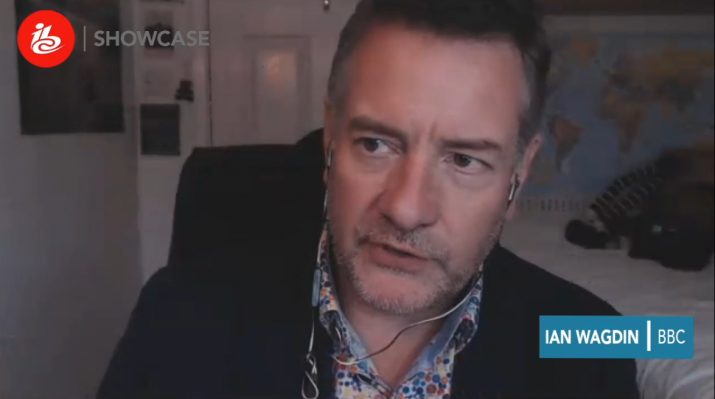
Ian Wagdin, BBC R&D, senior technology transfer manager
“It’s easy to do this stuff on paper; it’s really hard to actually make it work. But it is a unique opportunity for us as broadcasters to get our hands on all this kit outside of the show floor and really put it to the test. It’s also easy to view it in isolation, but actually seeing it all working together is far more realistic.
“For all of the champions, it’s just a great opportunity to have a really deep dive and to understand the technology and understand the limitations, and where this is going. It’s still an emerging use-space – really exciting,” said Wagdin.
For the 5G-enabled MTV Push Live remote production element, ViacomCBS Networks International (VCNI) and ViacomCBS Digital Studios International (VDSI) collaborated with IBC and VodafoneZiggo. The live show was recorded and broadcast live by VCNI with multiple AI cameras and drones.
Brendan Yam, SVP and general manager for VDSI, commented: “ViacomCBS Network International is connecting 5G network operators and the newest technologies with our iconic brands and broadcast innovations to push the boundaries of commercialising 5G today. This ‘MTV Push Live’ remote production over 5G with IBC and VodafoneZiggo does exactly that, and gives us another way to safely bring content to fans around the world.”
The key to the future of broadcast production is connectivity
IBC decided to maintain its Media Innovation Accelerator Programme initiative, launched in February, bringing together multi-company teams to develop solutions for real use cases. The Accelerator Programme is designed to encourage invention in areas such as 5G, augmented reality, television delivered as objects, VFX, animation, artificial intelligence and sustainability. IBC provided the framework for six months of open shared R&D, with the goal of unveiling the work during IBC Showcase.
“The IBC Accelerator programme is a framework to support industry collaboration and innovation,” said Mark Smith, leading the programme at IBC. “While the global pandemic stalled much of our planned lab testing and in-field experiments earlier in 2020, the team behind this unique collaboration of world leading broadcasting champions were determined to put their learnings into practice, against a backdrop of their organisations accelerating strategies to decentralise production and remote production capabilities.”
Two days before the proof of concept demonstration last week, the IBC Showcase featured a panel session aimed at setting the scene and providing context for the work of the 5G Accelerator. Moderated by Mark Smith and led by Ian Wagdin, the other speakers on the panel were Purminder Gandhu, technology transfer and partnerships manager, BBC Technology Strategy & Architecture; Matt Okotie, lead system engineer, ViacomCBS; Mario Reis, director of telecommunications at OBS; and Matt Stagg, director of mobile strategy for BT Sport.
“The broadcast use case is very challenging,” said Wagdin, “because we want to upload more data than we want to download. And that’s different to how most people use these types of networks.
“The broadcast use case is very challenging, because we want to upload more data than we want to download. And that’s different to how most people use these types of networks.” – Ian Wagdin
“The future will mean less centralised, less big-broadcast solutions. And the key to that is connectivity. It’s not all going to be 5G: some of it will be hybrid, some fibre, some WiFi. But we need to understand how all of those technologies mesh together.”
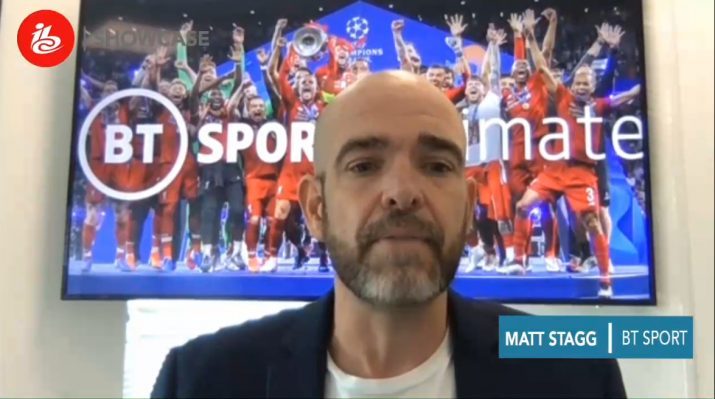
Matt Stagg, BT Sport, director of mobile strategy
“We wanted to know how we could use a 5G network to be able to [produce] a broadcast-grade network where you’re not subject to the amount of people using their phones in that area,” said Stagg. “We knew what we wanted. What we didn’t know was how many ways there were to realise that requirement.
“And everybody speaks a different language. How we educate the broadcast operators and also start to work more closely with the mobile operators?
“We looked first at the use cases. Then you come onto the different architectures and infrastructures you can have, with different devices and solutions around gateways. When we looked at that, it was clear that one size did not fit all. Breaking news is not going to be the same infrastructure as a golf tournament.
“We realised we had to split out into working groups. We had use cases and research; infrastructure; and then devices, gateways and innovations. We then realised how complex the spectral landscape can be so we started another working group looking at spectrum, led by the BBC,” said Stagg.
“Regardless of the broadcaster I spoke to,” said Gandhu, “there were distinct similarities in terms of
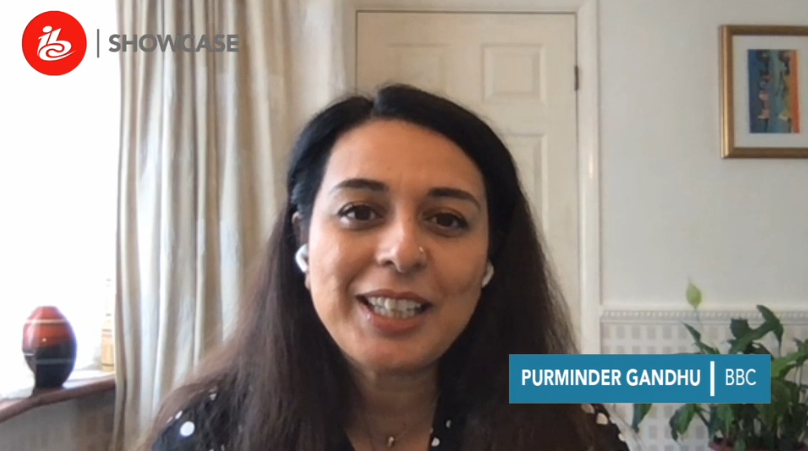
Purminder Gandhu, BBC Technology Strategy & Architecture, technology transfer and partnerships manager
the ambitions and requirements when 5G is finally in a position to provide us with the type of network we require. It ranged from really straightforward cases such a reporter talking to a guest, to being able to cover events with more creativity – the ability to have non-tethered cameras in an environment where you have fixed position cameras. This could apply for example to party political conferences.
“We then discussed things like large sporting events and being able to tap into existing infrastructure in sports stadiums – and having the flexibility to plug into that infrastructure. We also discussed planned versus non-planned events.
“Planned might mean a sporting victory parade, again with the flexibility to follow a team bus from the airport to the centre of a city. And being able to incorporate the use of drones for that type of coverage, including not having to have operators in highly congested areas.
“We also discussed the provision of 5G for these use-cases, whether non-public networks, slices of the network, or being able to utilise the public network where there is no other option. What are the latency issues in all of these situations?
“And could 5G enable a wider diversity of events, enabling us to cover lower tier sports events, entertainment applications like comedy, council meetings and so on? What was very clear was that being able to join up our thinking in this way would allow us to provide our audience with a much more engaged experience,” said Gandhu.
OBS discusses 5G remote production for Beijing 2022 Games
OBS director of telecommunications Mario Reis touched on possible 5G use cases for the 2022 Winter Olympics and Paralympic Games in Beijing in early 2022. OBS is developing cloud technology, a 5G network, together with Alibaba Group, which would allow broadcasters to work more efficiently and also enable more personalised viewing for consumers.
“We understood early on that if we wanted to use mobile networks we would need to engage with the partner ecosystem,” said Reis. “The mobile operators cannot operate on the basis of six or nine months time; they really need time to set up their own networks.
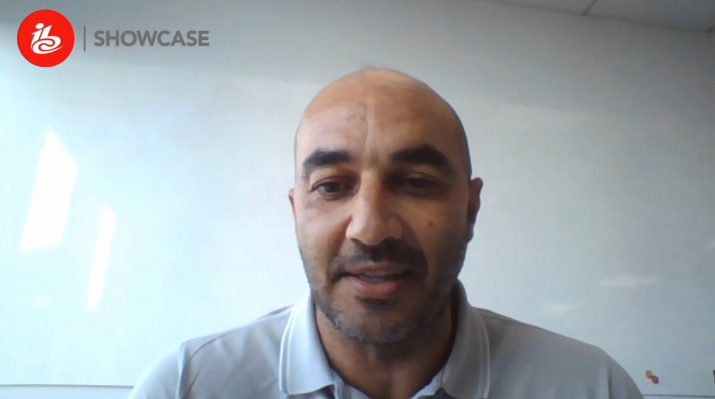
Mario Reis, OBS, director of telecommunications
“We had this experience with 3G back in Rio 2016, for very specific use cases. Then we made an attempt with 4G for another very specific use case. But we understood it needs a lot of time to plan for a big event like the Olympics, where we have a lot of venues and a lot of spectators.
“The challenge that we see is in resources – the scarcity of spectrum. UHD production is really bandwidth hungry. 4G technology definitely cannot cope with either bandwidth or latency.
“But most important, more than ever we want to leave a positive legacy in the host city. Big events are super cool, a moment to engage the whole world. But we need to be mindful of what we leave behind.
“The time has come for us to use more standardised, and less bespoke, solutions. This would mean less time for preparation, less time for set-up, less people in town – this is the legacy [we’re seeking], it is in our minds all the time. And society expects this from us, as a community.
“We’re now focusing on Beijing 2022. We really do need time to prepare, especially for a brand new technology. We think that together with our key partners, such as the telecommunications company and the local organising committee, we will most probably have the right set up.
“The Winter Games is smaller, in terms of number of venues and events. Therefore we have a little bit more of a buffer to test and trial – and we need this time to prepare the designs.
“One of the key benefits of this Accelerator Programme is to really leverage on the work of Purminder and the team on the ecosystem and the partners that need to be involved. This is a complex project. 5G is not easy. We as a community need to learn and need time to learn.
“This is leading us to develop a set of use cases for Beijing 2022. One is the beauty camera, which we typically used to connect using fibre and now are discussing using 5G – on a simple public network, nothing extraordinary.
“More specific use cases include outdoor events like alpine, where we want to put the camera at a very specific angle rather then deploy a long cable across the mountain. Cross-country is another example, where we want to check the handovers: what needs to run on the network to ensure the video doesn’t suffer?
“We are also testing indoor environments like curling, where if you have camera cables hitting the ice it is not nice for the athletes.” – Mario Reis
“We are also testing indoor environments like curling, where if you have camera cables hitting the ice it is not nice for the athletes. We have to consider spectrum in that use case as there are many devices operating in an indoor hall, where there is a lot of congestion due to number of spectators.
“In reality our drivers are to identify, as a broadcaster, what we need to ask of our mobile operator and our ecosystem of partners in terms of slicing, non-public networks and open round. We think that open standards foster innovation and democratise access in the broadcast ecosystem,” said Reis.
